Articles
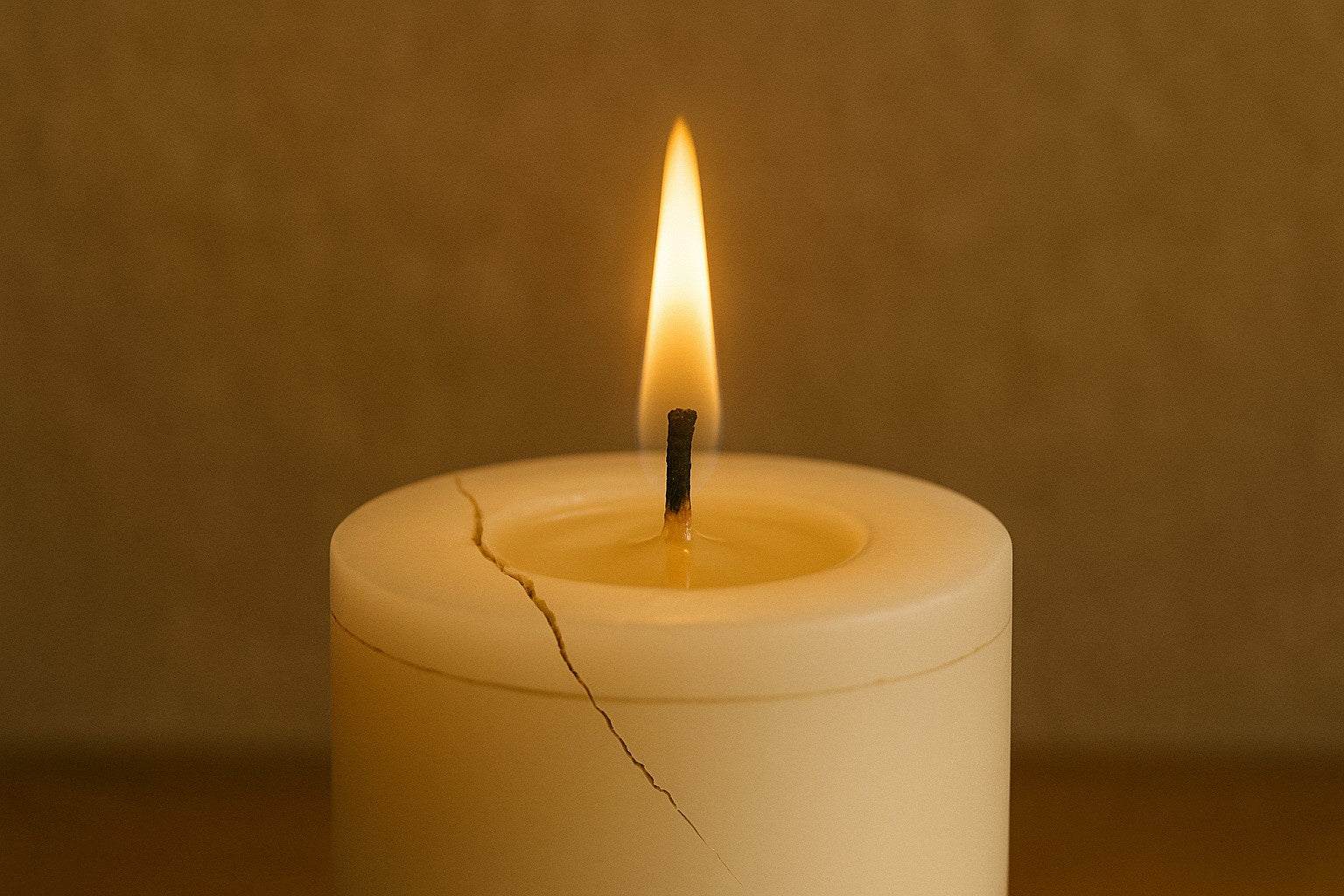
Article
Why Are My Candles Cracking?
You pour a fresh batch of candles, everything looks fine, then the surface splits. A thin crack in a circle on the candle surface. Maybe a deep split across the top. So what’s going on?
Candle cracking is one of the most common issues in candle making, especially with soy wax. The good news? It’s usually cosmetic and completely fixable. But if you want smoother tops and a more professional finish, let’s break down what causes cracks, and how to prevent them.
Why Are My Candles Cracking?
Cracking happens when the wax cools too quickly or unevenly. As wax contracts while it sets, any sudden change in temperature can cause surface tension that leads to splits, especially on the top layer.
Other times, the issue starts before the pour: wax that’s too cool, equipment that’s too cold, or environmental shifts in the workspace can all contribute to the problem.
Common Causes of Cracks in Candles
1. Pouring Wax at the Wrong Temperature
If you pour too cool, the wax may begin setting before it fully levels out in the container. Soy wax is especially sensitive to temperature, and slow cooling helps prevent cracking.Try this: Stick within the recommended pour temp for your specific wax. For most soy waxes, that’s around 120°F–135°F. Too hot, and you risk frosting or sinkholes; too cool, and you’ll likely see cracks.
2. Cold Containers or Workspace
A cold jar, tin, or room can shock the wax as it hits the surface. That quick temp drop locks the top before the rest settles underneath, leaving you with a cracked candle top.Fix it: Pre-warm containers slightly with a heat gun or in a warm oven (under 100°F). Keep your workspace above 70°F when pouring.
3. Improper Cooling Conditions
If you move candles too soon, set them near a draft, or let them cool unevenly, the top layer can form cracks.Tip: Let your candles cool slowly in a stable, draft-free space. Don’t refrigerate them or place them on cold surfaces like stone counters.
Why Are My Homemade Candles Cracking More Often?
Homemade candles, especially soy, tend to crack more than paraffin-based blends because of how natural wax behaves. Soy wax expands and contracts more during the cooling process, making it more vulnerable to cosmetic flaws like frosting, rough tops, and cracking.
If you're working with a 100% soy wax blend, dial in your pour temp and container temp, and allow time for a gradual cool-down. Using a soy-paraffin blend or adding a small percentage of coconut wax can sometimes help with texture and finish.
How to Fix a Cracked Candle
If your candle cracked on top but everything else looks good, don’t toss it. Here are a few quick fixes:
Use a heat gun: Lightly reheat the top of the candle until the wax melts just enough to level out. This smooths over most surface cracks.
Top it off: If the crack is deep, melt a small amount of the same wax and pour a thin layer over the top to even it out.
Repour and remix (if needed): For persistent cracking, revisit your wax temp, container conditions, and any additives you’re using.
How to Prevent Candles from Cracking
Preventing cracks is about controlling your environment and knowing your materials. Here's what helps:
Keep pour temperatures consistent and in range
Pre-warm containers, especially in cooler months
Avoid drafts or extreme temperature swings
Allow slow, uninterrupted cooling
Use waxes with smooth finish characteristics if surface appearance is a priority
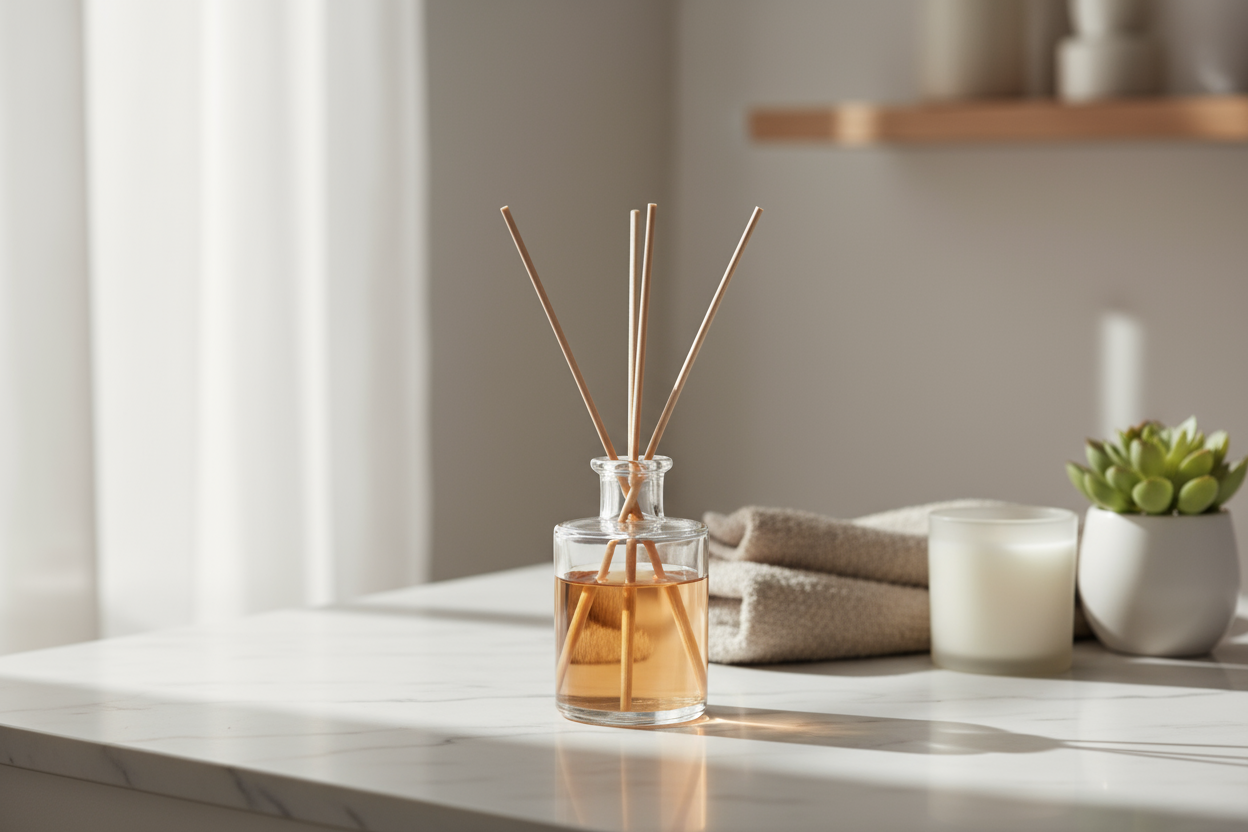
Article
How To Use Reed Diffusers & How They Work
Reed diffusers are a popular choice for adding a continuous, subtle fragrance to any room without the need for heat or flame. If you’re wondering “How do reed diffusers work?” or the best way to use them then we’ve got you covered. Here’s a complete guide to help you get started!
How Do Reed Diffusers Work?
A reed diffuser is made up of a glass or ceramic vessel filled with a fragrant oil mixture—often an essential oil reed diffuser blend—and a set of rattan reeds. These natural reeds draw the oil up, allowing the fragrance to evaporate, creating a consistently gentle scent. Unlike candles, reed diffusers work without requiring a flame or electricity.
How To Use Reed Diffusers
Using a reed diffuser is simple and mess-free. Here’s a quick rundown of the steps:
Set It Up: Remove the cap or stopper from the diffuser bottle. If you’re using a natural reed diffuser with a sealed closure, carefully pop the top off to reveal the fragrance oil.
Insert The Reeds: Place some of the reeds that come with the diffuser into the bottle. This ensures a consistent and pleasurable release of fragrances. For stronger scent throw, use all the reeds provided.
Flip The Reeds: After a few hours—or whenever the scent starts to fade—flip the reeds upside down. This refreshes the diffusion process by exposing the saturated ends to the air.
Placement: Set the diffuser on a stable, flat surface away from direct sunlight or heat sources to prevent the oil from evaporating too quickly.
Reed Diffuser Instructions
Use in a well-ventilated space.
Keep away from direct sunlight and drafts.
Flip reeds regularly (every week or so) to maintain a consistent scent.
FAQs
Do You Put All the Reeds in a Reed Diffuser?
Yes, it’s recommended to use all the reeds that come with your diffuser. This helps distribute the fragrance more evenly and ensures the scent is strong enough to fill the room.
What Are the Disadvantages of Reed Diffusers?
While reed diffusers offer a convenient and flame-free way to scent your space, they do have a few drawbacks:
The scent throw is typically lighter than candles or electric diffusers.
The fragrance may fade over time as the oil evaporates, requiring periodic flipping of the reeds.
They’re best suited for small to medium-sized rooms and might not be effective in very large spaces.
How Long Do Reeds Last in a Diffuser?
Reeds usually last between one and three months, depending on the oil quality, room conditions, and frequency of flipping. Over time, they can become saturated and clogged, which can reduce scent throw. Replace them as needed to keep the fragrance fresh.
Essential Oil Reed Diffuser Tips
For a natural, consistent scent experience, consider using specially formulated essential oil reed diffuser blends. High-quality oils not only smell amazing but also reduce the risk of reeds becoming clogged too quickly.
Wrap Up
A natural reed diffuser is a simple, flame-free way to enjoy fragrance in your home. Just remember to set it up properly, flip the reeds regularly, and replace them when needed to keep the scent fresh. With the right essential oil reed diffuser, you’ll be able to fill your space with a continuous, inviting aroma that elevates your environment.
Legal Disclaimer: Always follow safety guidelines when using reed diffusers. Keep away from children and pets, and ensure that all materials comply with IFRA standards and are intended for safe home use.
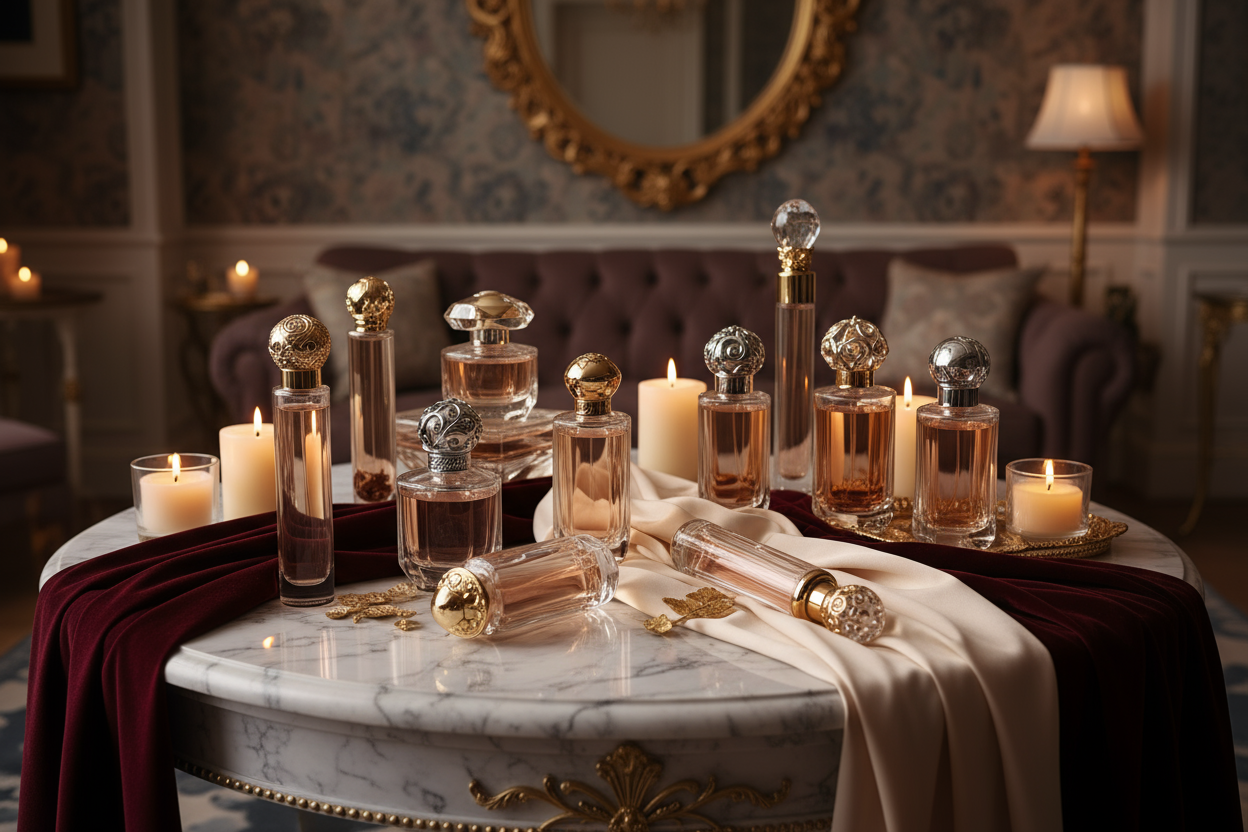
Article
Alternate Fragrance Comparison Guide
For candle makers looking to capture the luxurious experience of high-end perfumes without the steep cost, The Flaming Candle’s collection of designer-type fragrance oils has what you want. These scent-forward fragrance oil dupes are crafted to reflect the signature profiles of popular designer perfumes—giving you the creative freedom to build a premium-feeling candle line with reliable, affordable ingredients.
This guide walks through how fragrance dupes work, answers common questions, and provides a side-by-side comparison chart based on our in-house line.
What Are Designer-Type Fragrance Oils?
Designer-type fragrance oils are created to match the general scent profile of well-known perfumes, colognes, and signature home fragrances. While they don’t replicate formulas note for note (and can’t use trademarked names), they offer a familiar aromatic experience for customers who know and love those originals.
Each fragrance is made using a blend of synthetic aroma chemicals, natural isolates, and essential oils when applicable—all designed for candle making. At The Flaming Candle, our designer-type fragrances go through rigorous and thorough testing for scent throw, stability, and safety to ensure they work across wax types, from soy to paraffin.
Are Fragrance Dupes Worth It?
For most small-batch candle makers, fragrance dupes offer a high-value way to meet customer demand for recognizable scents without overextending on raw material costs. Here’s why they’re worth considering:
Cost Savings Sourcing actual designer perfumes for candles would be financially unrealistic and legally problematic. Fragrance dupes provide a safe, budget-friendly workaround.
High Performance The Flaming Candle’s oils are made for candle use, meaning they throw well hot and cold and are often more stable in wax than essential oils or diluted perfume bases.
Familiar Appeal People love recognizing an aroma. Being able to say a candle smells like something that sparks joy, gives it an immediate place in someone’s memory.
Creative Flexibility Since you’re working with familiar bases, you can layer designer-type oils with complementary scents to create hybrid blends that still feel elevated and original.
The Flaming Candle Fragrance Oil Comparison Chart
Here’s a quick-reference guide comparing some of our top-performing designer-type fragrance oils with the scents they’re inspired by. This is a working reference—always test in your wax base to ensure the experience meets your expectations.
The Flaming Candle Fragrance Oil
Inspired By
Bombshell (Type)
Victoria’s Secret Bombshell
Amber Romance (Type)
Victoria’s Secret Amber Romance
Volcano (Type)
Capri Blue Volcano
Sweater Weather (Type)
Bath & Body Works Sweater Weather
Twilight Woods (Type)
Bath & Body Works Twilight Woods
Tis the Season (Type)
Bath & Body Works Tis the Season
Fierce (Type)
Abercrombie & Fitch Fierce
Polo Red (Type)
Ralph Lauren Polo Red
Narcissist (Type)
Narciso Rodriguez For Her
Gain (Type)
Gain Laundry Detergent (Original Scent)
Storm Watch (Type)
Yankee Candle Storm Watch
Strawberries & Champagne (Type)
Victoria’s Secret Strawberries & Champagne
Note: These are fragrance oil dupes—not exact matches or formulations. All fragrance oils at The Flaming Candle are free from trademarked branding and follow IFRA usage guidelines.
How to Work With These Oils in Candle Making
Designer-type fragrance oils behave similar to other premium fragrance blends. Here’s how to get the most out of them:
Use within safe loading limits
Each fragrance oil includes recommended usage percentages by wax type. Always refer to the IFRA certificate and conduct wick testing to confirm your final formula is safe and effective.
Expect layered scent profiles
Because these oils are inspired by perfumes, you’ll notice that they often include strong top, mid, and base notes. In candles, this means the hot throw can evolve as the candle burns—similar to how perfume changes on skin.
Store properly
To maintain stability and integrity, keep your oils tightly sealed in a cool, dry space away from light. Designer-type blends can be more sensitive to storage conditions.
Can I Blend These With Other Oils?
Absolutely. Many candle makers layer designer-type oils with single-note fragrance oils to adjust sweetness, depth, or freshness. For example:
Add a Citrus Burst to brighten up Amber Romance (Type).
Layer Warm Vanilla Sugar (Type) with Twilight Woods (Type) for a sweeter base.
Try Mahogany Teakwood (Type) and Sweater Weather (Type) together for a crisp, cozy blend.
As always, test small batches to see how your combination behaves in your chosen wax and container.
Final Thoughts
Fragrance oil dupes aren't just a budget alternative—they’re a creative tool that lets candle makers offer popular scents without needing expensive raw materials or licensing agreements. With The Flaming Candle’s designer-type collection, you have access to a curated range of scents that evoke the feel of beloved perfumes and lifestyle brands—without compromising on performance or safety.
If you're developing a new line, running seasonal experiments, or just curious what your favorite perfume might smell like in wax, these oils are a smart place to start. Explore our full collection now.
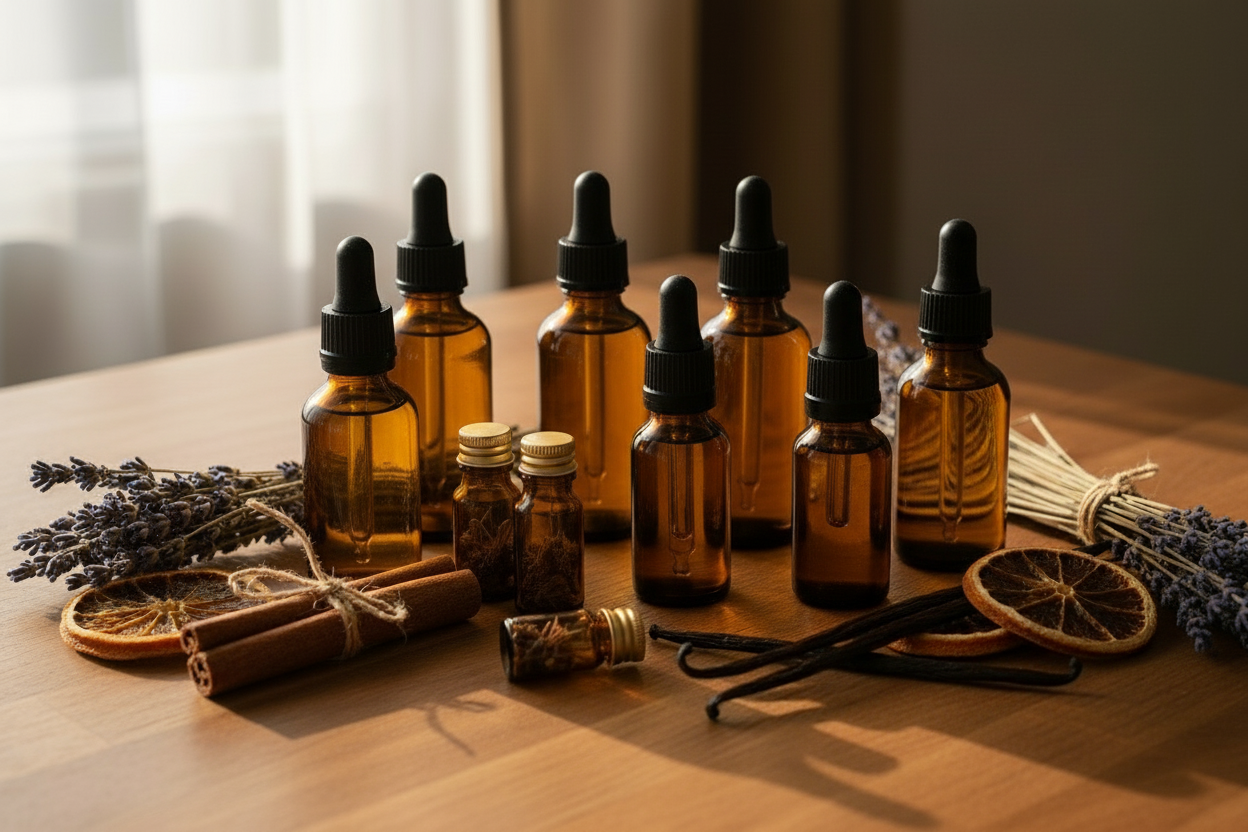
Article
Essential vs. Fragrance Oil: Understanding the Difference for Candle Makers
Some candles smell like fresh baked cookies. Others smell like crisp eucalyptus. It all depends on whether essential oils or fragrance oils were used to make the candle. Both types of oils do more than give a candle an aroma. They have unique properties and performance. Understanding the difference between essential oils vs fragrance oils is key to candle making–whether you’re crafting for personal use or building a product line.
Here's what you need to know.
What Are Essential Oils?
Essential oils are concentrated plant extracts obtained from steam distillation or cold pressing. They capture the natural aroma found in flowers, leaves, peels, bark, roots, etc. They’re often used in aromatherapy.
Essential oils are all-natural and highly sought after for their scent and candle-making potential. But here’s the thing: not all essential oils hold up well in heat. Some fade quickly or behave unpredictably. It’s crucial to know which essential oils perform best if you want to make the most of your candles.
Common Extraction Methods:
Steam Distillation – Used for most plant materials; it involves heating the plant matter to release vaporized oil.
Cold Pressing – Mainly for citrus peels like lemon and orange; no heat is used, which helps preserve delicate top notes.
What Are Fragrance Oils?
Fragrance oils are manufactured scents made in a lab using aroma compounds—both synthetic and naturally derived. They may contain essential oils, but they're usually blended with synthetic materials to mimic natural aromas or create entirely new ones you’d never find in nature like, “Birthday Cake” or “Ocean Breeze”.
Because fragrance oils are engineered for performance, they’re designed to maintain a strong, stable scent throughout the life of a candle. They’re also tested for flash point and compatibility with wax types, which gives candle makers more predictability and control during production.
How Are Fragrance Oils Made?
Fragrance oils typically include:
Aroma Chemicals – These give the oil its distinct scent.
Solvents or Carriers – These help stabilize and dilute the fragrance to usable levels.
Essential Oil Blends (optional) – Some fragrance oils include small amounts of natural oils for complexity or realism.
Key Differences Between Essential and Fragrance Oils
Feature
Essential Oils
Fragrance Oils
Source
Naturally derived from plants
Synthetic and/or blended with natural compounds
Scent Range
Limited to what exists in nature
Unlimited, including fantasy scents
Performance in Candles
Unpredictable; may fade or burn off
Strong scent throw, consistent performance
Cost
Usually higher due to extraction process
Generally more affordable and scalable
Safety Considerations
Can be irritating in high concentrations
Formulated for cosmetic and candle use under IFRA guidelines
Are Fragrance Oils Safe to Breathe?
Fragrance oils from reputable suppliers like The Flaming Candle are tested to meet IFRA (International Fragrance Association) standards. These standards set maximum usage levels for various applications—including candles—to help minimize risks like skin irritation or hormone disruption. Still, not all noses are created equal. Some people may be sensitive to certain aroma chemicals, so ventilation and label transparency are key when working with any scented candle.
Why Scent Throw Matters in Candle Making
Scent throw—both hot (when lit) and cold (when unlit)—is one of the biggest reasons many makers lean toward fragrance oils. Essential oils often struggle to fill a room with scent unless used in very high concentrations, which can exceed safe usage rates or affect how the candle burns.
Fragrance oils, on the other hand, are optimized for candle wax. They provide rich, consistent aroma with less oil required. That means better results, less waste, and fewer safety issues during burn.
Can Essential Oils Be Used as Fragrance?
Yes, but with caution. Essential oils can be used in candle making if you understand their limits. Some oils—like citrus or floral types—are delicate and may lose their scent quickly or burn off entirely. Others, like patchouli or cedarwood, are more resilient. If you’re using essential oils:
Keep fragrance loads low to stay within safe limits.
Monitor how the oil performs during test burns.
Pair with hard waxes for better retention.
Which Lasts Longer: Essential Oils vs Fragrance Oils
In most cases, fragrance oils have more staying power. Their scent holds up over time, and they resist degradation better than essential oils, which are more volatile and sensitive to heat, light, and oxidation. For shelf stability and long-term scent, fragrance oils win.
What Should Candle Makers Use?
If your priority is a clean-label product with simple, botanical ingredients, essential oils might suit your vision—as long as you can live with a subtler scent. But if you need bold, consistent aroma and wider scent options, fragrance oils are a better tool for the job.
Things to Consider:
Audience expectations: Are your customers looking for “natural” or “long-lasting”?
Product use case: Is this a luxury candle, a seasonal launch, or an everyday scent?
Cost and scalability: Essential oils can get expensive fast in larger batches.
Performance testing: Always do a burn test before releasing a new formula.
Final Thoughts
The winner between essential oils vs fragrance oils isn’t a matter of which is better—it’s about what fits your product goals. Both have their place in candle making, and many crafters even use blends to strike a balance between natural appeal and performance. Whichever you choose, always source high-quality oils, follow IFRA guidelines, and test your candles thoroughly before sharing them with customers.
Disclaimer: This information is intended for educational purposes only. It is not medical advice, and The Flaming Candle does not make any therapeutic or health-related claims regarding the use of essential or fragrance oils. Always follow proper handling guidelines and test products thoroughly.
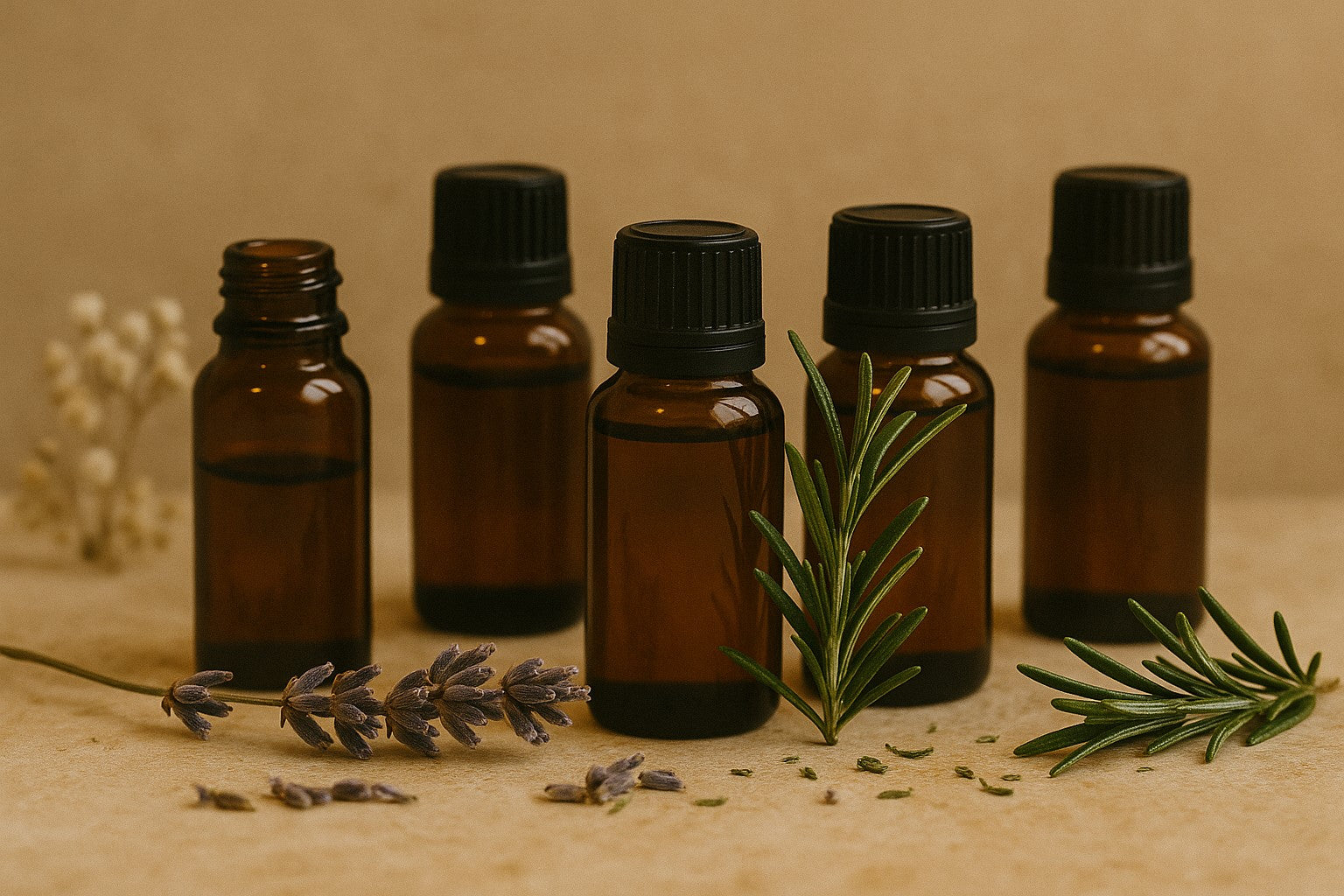
Article
Scents and Aromatherapy Guide
Aromatherapy with candles is popular for a reason. It’s a sensory tool for enhancing mood, focus, and relaxation. Whether you're a seasoned candle maker or just starting out, understanding the differences between fragrance oils and essential oils can help you craft candles that not only smell great but also provide a calming effect.
Fragrance Oils vs. Essential Oils: What's the Difference?
Fragrance OilsFragrance oils for candles are synthetic or blended oils designed specifically for scenting products. High-quality fragrance oils for candles are formulated to be safe and stable when heated, offering a wide range of scents not always available in nature. They provide consistent scent throw and are often the go-to choice for candle makers aiming for specific fragrances.
Essential OilsDerived from plants through methods like steam distillation, essential oils are natural and carry the essence of the source material. Commonly used in aromatherapy, they are known for their therapeutic benefits. However, not all essential oils are suitable for candle making due to their volatility and flash points.
Choosing the Best Candle Scents for Aromatherapy
When selecting scents for aromatherapy candles, consider the desired effect:
Relaxation: Lavender, chamomile, and sandalwood are popular for their calming properties.
Energy Boost: Citrus scents like lemon and orange can invigorate and uplift.
Focus: Peppermint and eucalyptus are known to enhance concentration.
Combining essential oils and fragrance oils can create unique blends that cater to specific moods and preferences.
The 30/50/20 Rule for Blending Oils
For a harmonious scent profile, follow the 30/50/20 rule:
30% Top Notes: These are the first scents perceived and evaporate quickly (e.g., citrus oils).
50% Middle Notes: The heart of the fragrance, providing balance (e.g., lavender, rosemary).
20% Base Notes: These linger the longest and add depth (e.g., sandalwood, patchouli).
This ratio helps in creating well-rounded and appealing scents for candles.
Incorporating Aromatherapy into Candle Making
To create candles that offer aromatherapy benefits:
Select Appropriate Oils: Ensure the oils are safe for candle use and have the desired therapeutic properties.
Use Soy Wax: Soy wax is known for its clean burn and excellent scent throw, making it ideal for aromatherapy candles.
Test Your Blends: Always test your oil blends in small batches to ensure the scent is pleasant and the candle burns safely.
Remember, while candles can enhance mood and ambiance, they are not a substitute for medical treatments.
Final Thoughts
Understanding the nuances between fragrance oils for candles and essential oils allows for more intentional candle crafting. With the right oils and careful blending, you can create candles that smell delightful and are great for aromatherapy.
Note: Always ensure that the oils used are appropriate for candle making and adhere to safety guidelines. The information provided is for educational purposes and not intended to diagnose, treat, or cure any medical conditions.
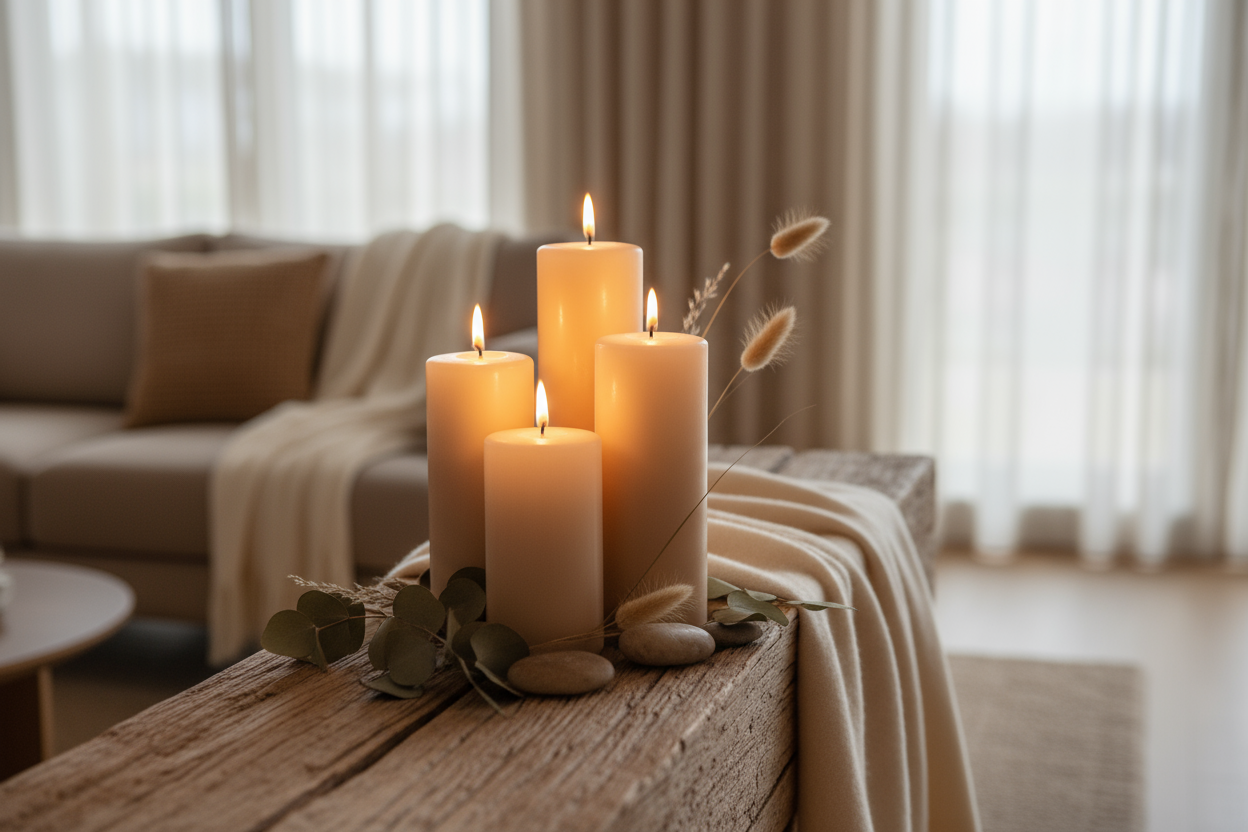
Article
How to Make a Pillar Candle
Pillar candles offer a timeless aesthetic and a satisfying DIY project. With the right materials and technique, you can create elegant, long-burning candles that complement any space.
Choosing the Right Pillar Candle Wax
Selecting the appropriate wax is crucial for successful pillar candle making. Pillar candles require waxes that are firm enough to hold their shape without a container and have good mold release.
Recommended Waxes:
Paraffin Wax: Known for its excellent scent throw and ability to hold color well, paraffin is a popular choice for pillar candles. It has a low melting point, making it suitable for molds and providing a smooth finish.
Soy Wax Blends: While pure soy wax is softer and typically used for container candles, certain soy wax blends are formulated for pillars. These blends offer a natural alternative with good scent throw and mold release.
Beeswax: A natural option that burns longer and cleaner than other waxes. Beeswax has a high melting point and emits a subtle, natural fragrance.
Essential Supplies
Before you begin, gather the following materials:
Pillar candle wax (paraffin, soy blend, or beeswax)
Pillar candle mold (metal, plastic, or silicone)
Wick suitable for the diameter of your mold
Wick sustainer tab
Wick centering device (e.g., wick bar or pencil)
Fragrance oil (optional)
Candle dye (optional)
Double boiler or melting pot
Thermometer
Pouring pitcher
Heat-resistant surface
Step-by-Step Guide to Making a Pillar Candle
Prepare the Mold: Ensure your mold is clean and dry. Insert the wick through the bottom hole, securing it with a wick sustainer. Use a wick centering device to keep the wick centered at the top.
Melt the Wax: Using a double boiler, melt the pillar candle wax to the manufacturer's recommended temperature. Monitor the temperature with a thermometer to avoid overheating.
Add Fragrance and Dye: Once the wax reaches the appropriate temperature, add fragrance oil and dye if desired. Stir gently to ensure even distribution.
Pour the Wax: Slowly pour the melted wax into the mold, leaving a small gap at the top. Tap the mold gently to release any air bubbles.
Cool and Refill: As the wax cools, it may sink in the center. Reheat and pour additional wax to fill any sinkholes, ensuring a smooth top surface.
Unmold the Candle: Allow the candle to cool completely. Gently remove it from the mold by pulling on the wick while angling the mold downward. If the candle is stuck, gently squeeze the sides of the mold or roll it on a flat surface using gentle pressure to help it release.
Trim the Wick: Cut the wick to approximately ¼ inch (6 mm) to ensure a proper burn.
Tips for Success
Mold Release: If you're using a metal mold, consider applying a mold release spray, which acts as a lubricant, to facilitate easier removal.
Fragrance Load: Be mindful of the maximum fragrance load your wax can handle to prevent issues like sweating or poor burn performance.
Testing: Always conduct a burn test with a single candle before producing larger batches to assess performance and make necessary adjustments.
Creating pillar candles allows for customization in shape, color, and scent, making them a versatile addition to any space or product line. With careful attention to detail and quality materials, you’ll craft beautiful candles with radiant, delightful fragrances.
Legal Disclaimer: Always follow safety guidelines when making candles. Use appropriate equipment, work in a well-ventilated area, and never leave melting wax unattended. Ensure that all materials used are suitable for candle making and comply with relevant regulations.
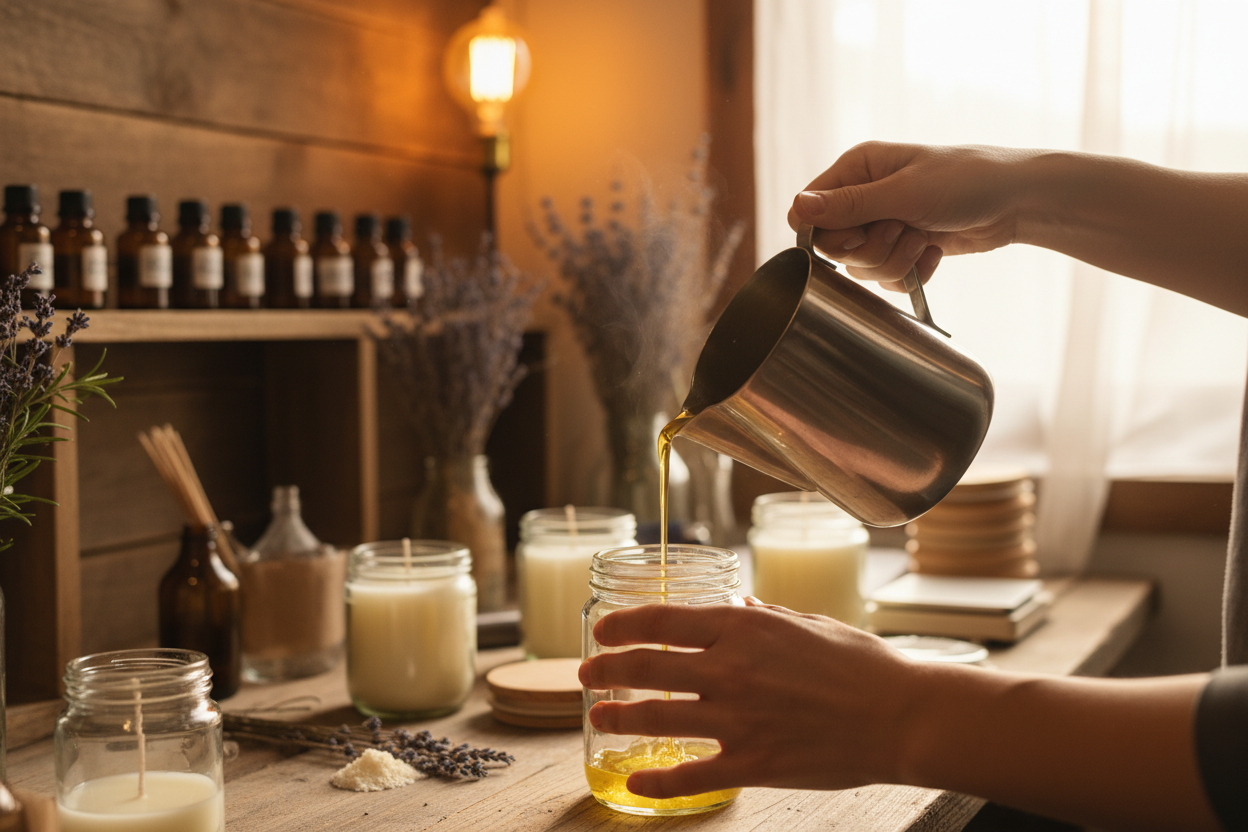
Article
Fragrance Load Calculator: What Is My Fragrance Load?
Achieving the perfect balance of wax and fragrance oil is key to crafting candles with an excellent scent throw. Our Fragrance Load Calculator simplifies this process by helping you determine the exact fragrance load for your recipe. This ensures your candles are both safe and aromatic.
What Is Fragrance Load in Candle Making?
Fragrance load refers to the percentage of fragrance oil in relation to the total weight of wax used in a candle. It determines how strong the scent of your candle will be. Different wax types have varying maximum fragrance load capacities, which is why calculating the right amount is essential.
For example:
A soy wax fragrance load typically ranges from 6% to 10%.
Exceeding the recommended load can lead to issues like sweating, poor scent throw, or unsafe burning.
Using a candle fragrance load calculator ensures you stay within these limits for optimal performance.
Download the Fragrance Load Calculator
Check out our other calculator tools as well!
How to Use the Fragrance Load Calculator
Input your wax weight: Enter the total amount of wax you’ll be using, measured in pounds.
Add your fragrance oil weight: Input the amount of fragrance oil you’re planning to use, measured in ounces.
View your result: The calculator will display the fragrance load percentage, helping you adjust your recipe as needed.
Example Calculation:
Wax weight: 2 lbs
Fragrance oil weight: 2 oz
Formula:
(Fragrance oil weight / Total wax weight) x 100 = Fragrance Load %
(2 / 32) x 100 = 6.25%
This calculation confirms your fragrance load is within a safe and effective range.
Why Fragrance Load Matters for Different Wax Types
Every wax type has a unique maximum fragrance load capacity:
Soy wax: 6-10%
Paraffin wax: Up to 12%
Coconut wax blends: Up to 12%
Staying within these limits ensures:
Strong scent throw.
Proper burning and wick performance.
Reduced risk of fragrance oil separating or sweating.
Common Fragrance Load Percentages for Candle Makers
Here are typical ranges:
6-8%: Light scent throw, ideal for subtle fragrances or smaller spaces.
8-10%: Balanced scent throw, suitable for most candle projects.
10-12%: Strong scent throw, often used for larger spaces or specialty wax blends.
Tips for Optimizing Your Fragrance Load
Choose the right wax: Each wax type has specific limits, so always check manufacturer recommendations.
Test small batches: Experiment with different percentages to find the ideal fragrance load for your desired scent strength.
Weigh accurately: Use a digital scale for precise measurements of wax and fragrance oil.
Consider the environment: Higher fragrance loads may perform differently in hot or humid climates.
With these tips and our Fragrance Load Calculator, you can craft candles with perfect scent strength and performance every time. Download the calculator here and simplify your candle-making process!

Article
Candle Batch Calculator: How Much Wax Do I Need?
Planning your next candle batch doesn’t have to be complicated. Our Candle Batch Calculator makes it easy to determine exactly how much wax you’ll need for your project. Whether you're crafting a single candle or preparing a large batch, this tool helps you achieve the perfect results every time.
What is a Candle Batch Calculator?
A Candle Batch Calculator is a simple yet powerful tool designed to help candle makers calculate the exact amount of wax required for their projects. By factoring in the number of candles, container size, and the weight of any additives like fragrance oil, it ensures you use the right amount of materials without waste.
This calculator is ideal for:
Beginners learning how to measure materials.
Professionals scaling up for bulk production.
Hobbyists aiming to perfect their candle recipes.
Download the Candle Batch Calculator
Check out our other calculator tools as well!
How to Calculate the Amount of Wax for Your Candles
Calculating wax for your candles involves a few simple steps to help you calculate how much wax for candle projects efficiently:
Decide how many candles you want to make: Multiply the container size by the number of candles.
Determine the size of your containers: Know the weight capacity (in ounces) of each candle container. Note: This should not be volume.
Factor in fragrance oil and more: Subtract the weight of fragrance oil and other additives from the total to calculate the wax weight. Use a standard fragrance load (6-10%) for accuracy.
Example:
Each container holds 8 ounces.
You’re making 10 candles.
You’re using a fragrance load of 8% (0.64 ounces per candle).
Calculation:
10 (candles) x 8 (ounces per container) = 80 total ounces. 80 - (10 x 0.64) = 73.6 ounces of wax needed.
Step-by-Step Guide to Using the Candle Batch Calculator
Input the number of candles: Enter how many candles you plan to make.
Enter the wax capacity of each container: Provide the size of your containers in ounces.
Add fragrance oil weight: Include the weight of fragrance oil you plan to use for your fragrance load.
Get your result: The calculator will provide the total amount of wax needed for your batch.
With this tool, you’ll save time and avoid over- or under-estimating your materials.
Frequently Asked Questions About Wax Calculations
Q: How do I calculate how much candle wax I need?
A: Multiply the number of candles by the container size (in ounces) and subtract the weight of fragrance oil based on your chosen fragrance load.
Q: Can I use the calculator for soy wax?
A: Yes! The calculator works for all wax types, including soy, paraffin, and blends.
Q: What is the typical fragrance load for candles?
A: Most candle makers use a fragrance load of 6-10%, depending on the type of wax.
Q: Is this calculator suitable for bulk production?
A: Absolutely! The calculator is designed to handle both small and large batch sizes with ease.
Q: Where can I download the calculator?
A: You can download the Candle Batch Calculator from The Flaming Candle.
Take the guesswork out of your candle-making projects with our user-friendly calculator. Download it today and create perfect batches every time!
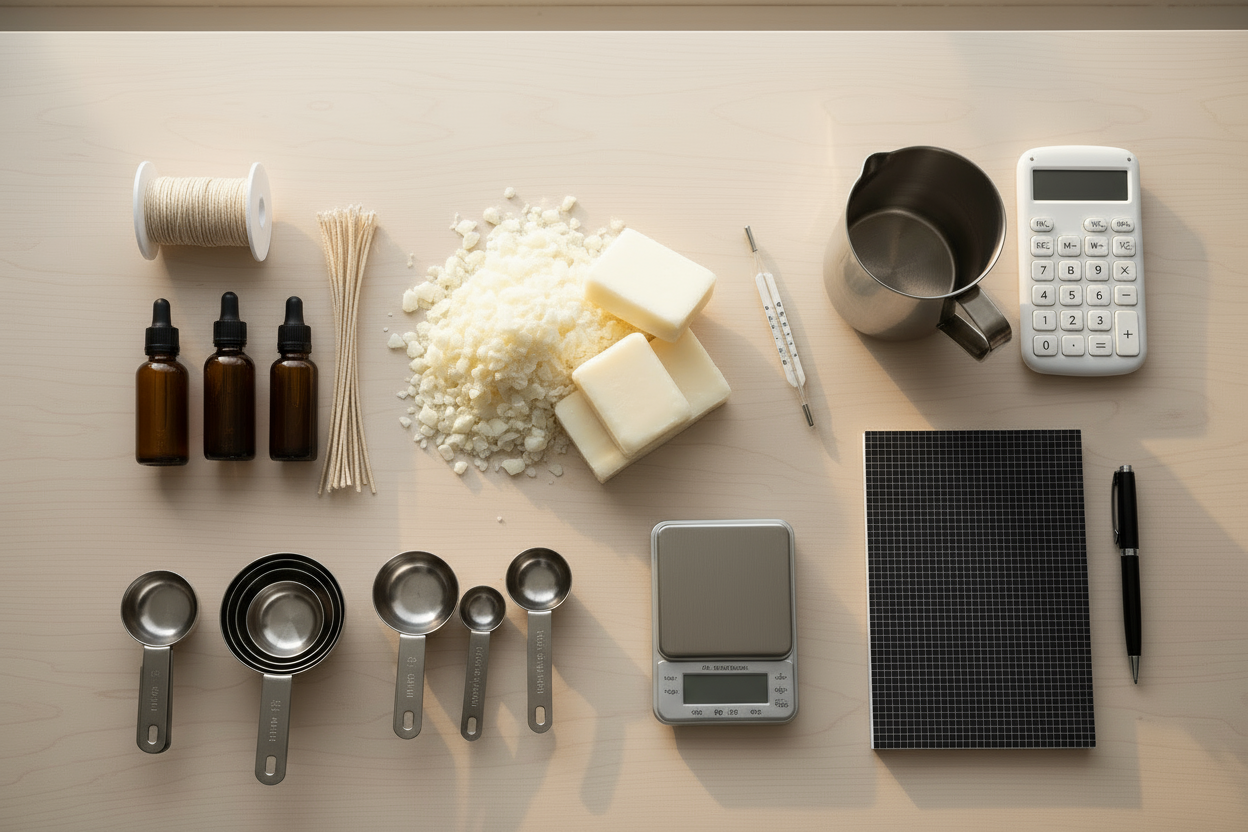
Article
Fragrance Oil Calculator: How Much Fragrance Oil for Candles?
Creating the perfect candle requires precision, especially when it comes to adding fragrance oil. Our Fragrance Oil Calculator takes the guesswork out of the equation, helping you determine exactly how much fragrance oil you need for any candle-making project. Download the calculator to streamline your process and achieve consistent results.
How to Use the Fragrance Oil Calculator
Using our Fragrance Oil Calculator is simple:
Enter the amount of wax you’ll be using (in pounds).
Input the desired fragrance load percentage.
The calculator will instantly provide you the amount of fragrance oil (in ounces).
This tool is ideal for both beginners and experienced candle makers who want precise results every time.
Download the Fragrance Oil Calculator
How to Calculate Fragrance Oil for Candles
Calculating fragrance oil manually can seem complicated, but understanding the math behind it can help you achieve perfect results. Here’s the formula broken down:
Start with the weight of wax you’ll use: This forms the base of your calculation. Accurate measurement is crucial because the wax weight directly impacts the fragrance load.
Choose your fragrance load percentage: This determines how strong your candle’s scent will be. Fragrance load percentages typically range between 6-10%, depending on the wax’s capacity and your desired scent strength.
Multiply the wax weight by the fragrance load percentage: Converting the percentage into decimal form ensures the calculation is precise. The resulting figure gives you the exact weight of fragrance oil required.
Why This Calculation Works
The fragrance load percentage represents the proportion of fragrance oil in relation to the total wax weight. By multiplying the wax weight by this percentage, you’re calculating a balance that maximizes scent throw without compromising the candle’s structure. Using an appropriate fragrance load also ensures the candle burns evenly and safely.
Example:
For 1 lb of wax with an 8% fragrance load:
1 (wax weight) x 0.08 (fragrance load in decimal form) = 0.08 lbs (1.28 oz) of fragrance oil.
This method ensures your candles are both fragrant and functional, creating a professional-quality product every time.
How Much Fragrance Oil for Common Candle Sizes?
Here’s a quick reference for popular candle sizes:
8 oz candle: Use approximately 0.48–0.64 oz of fragrance oil for a 6–8% fragrance load.
16 oz candle: Use approximately 0.96–1.28 oz of fragrance oil for a 6–8% fragrance load.
1 lb wax: Use 0.96–1.28 oz of fragrance oil for a 6–8% fragrance load.
Using our Fragrance Oil Calculator for Candles ensures these measurements are accurate and easy to calculate.
Tips for Getting the Best Results with Your Fragrance Oil Calculator
Check your wax type: Different waxes, like soy wax or paraffin wax, have varying maximum fragrance load capacities.
Use quality oils: Higher-quality fragrance oils yield better scent throw and overall performance.
Measure accurately: Use a digital scale to ensure precision.
Follow safety guidelines: Avoid exceeding the recommended fragrance load to prevent issues like sweating or poor burn performance.
Frequently Asked Questions About Fragrance Calculations
Q: Can I use the calculator for essential oils?
A: Yes, the calculator works for both fragrance and essential oils.
Q: What’s the ideal fragrance load percentage?
A: It depends on your wax. Most candle makers stick to 6–10%.
Q: How do I calculate fragrance oil for a batch of candles?
A: Enter the total weight of wax you’ll be using into the calculator to determine the exact amount of oil needed for your entire batch.
Q: Can I exceed the recommended fragrance load?
A: No, exceeding the maximum can cause safety and performance issues, including wick clogging and poor scent throw.
Q: Where can I download the calculator?
A: On The Flaming Candle website!
By using this tool, you can perfect your candle recipes and create consistently amazing products. Download the calculator today and enjoy hassle-free candle making!

Article
Wax Use Calculator: How Many Candles Can I Make With My Wax?
Planning a candle-making project and wondering how many candles you can create with your wax? Our Wax Use Calculator is the perfect tool to give you quick and accurate answers. Download the calculator to take the guesswork out of your crafting process and plan your candle batches efficiently.
What is a Wax Use Calculator?
A Wax Use Calculator helps candle makers determine the number of candles they can produce based on the total weight of wax they have and the size of each candle container. By factoring in additional components like fragrance oil, the calculator ensures precision in your measurements, saving time and reducing waste. Whether you're a hobbyist or a professional, this tool simplifies your workflow.
Download the Wax Use Calculator
Check out our other calculator tools as well!
How to Use the Candle Wax Calculator
Using the Candle Wax Calculator is straightforward:
Enter the total weight of your wax: A separate calculator is provided to help convert pounds into ounces for use in calculating the rest.
Add the weight of additional components: Include fragrance oil or other additives if applicable.
Specify the amount of wax each container will hold: This is typically the weight provided by the container or mold being used.
Review your results: The calculator will instantly display the total number of candles you can make.
This simple process ensures that your resources are used efficiently, helping you avoid overestimating or underestimating your batch size.
How Many Candles Can I Make With 1lb of Wax?
Knowing how many candles you can make with 1lb of wax depends on understanding your wax-to-container ratio. Here’s a breakdown:
1 lb of wax equals 16 ounces.
Each container’s capacity (in ounces) determines how much wax you’ll use per candle.
For example, if your containers hold 6 ounces of wax each:
1 (total wax weight in pounds) x 16 (ounces per pound) ÷ 6 (wax per container) = 2.67 candles.
This calculation shows that you can make two full candles with a little wax left over. The free candle wax calculator simplifies this by accounting for factors like fragrance oil and container sizes, so you can adjust your recipe accurately and avoid guesswork.
Tips for Accurate Candle Wax Measurements
Use a digital scale: Accurate measurements of wax and fragrance oil are critical for professional-quality candles.
Account for fragrance oil: Incorporate the weight of fragrance oil into your calculations to ensure proper fill levels.
Check your container sizes: Verify the actual wax capacity of your containers to avoid overfilling or waste.
Plan for some excess: It’s always a good idea to have a little extra wax on hand for mishaps or test pours.
Frequently Asked Questions About Candle Wax Calculations
Q: Can I use this calculator for soy wax?
A: Yes! The calculator works with all types of wax, including soy, paraffin, and blends.
Q: How does fragrance oil affect the calculation?
A: Fragrance oil adds weight, so be sure to include it in your total weight to ensure accurate results.
Q: What if my container sizes vary?
A: Use the calculator for each container size separately to get precise totals for mixed batches.
Q: Can I calculate wax usage for wax melts?
A: Yes, simply input the weight of your wax and the capacity of your wax melt molds.
Q: Where can I download the calculator?
A: You can download the Wax Use Calculator on the website.
With our calculator, you’ll always know exactly how many candles you can create, ensuring a smooth and efficient candle-making process. Download it today and enjoy stress-free crafting!
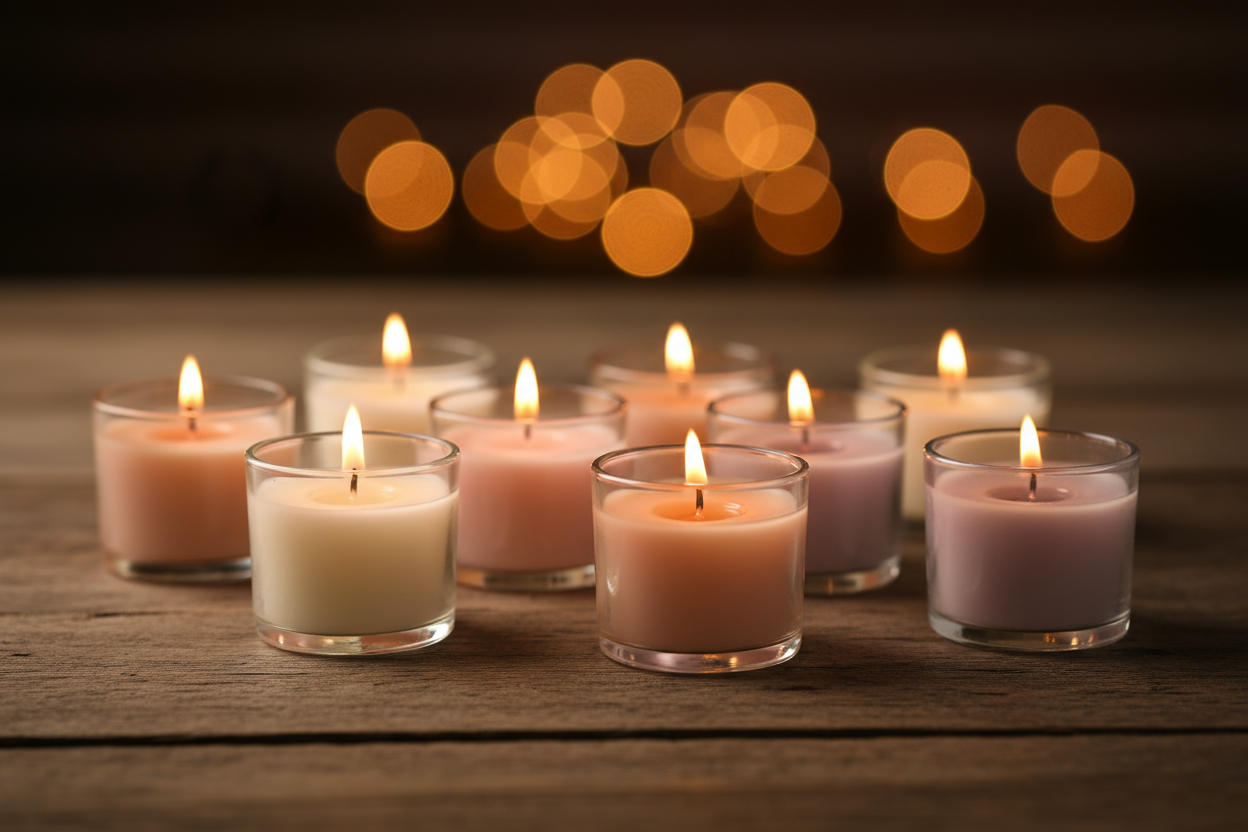
Article
What is a Votive Candle?
Votive candles have been a timeless staple in the world of candle making and home decor. Their compact size and versatile uses make them a favorite among candle enthusiasts. But what exactly is a votive candle, and how does it differ from other types of candles? This guide will provide all the details you need to know about votive candles and their unique features.
Defining a Votive Candle
A votive candle is a small, cylindrical candle typically measuring about 2 inches in height and 1.5 inches in diameter. Unlike larger pillar candles or container candles, votive candles are designed to be burned in a votive holder. These holders catch the melted wax as the candle burns, making them both functional and aesthetically pleasing.
The name "votive" is derived from their historical use in religious or spiritual settings, where they were often lit as offerings or prayers. Today, votive candles are widely used in various settings, from home decor to special events, thanks to their compact size and versatility.
Why Use Votive Candles?
Votive candles are popular for several reasons:
Versatility: These candles fit seamlessly into a variety of holders, allowing you to customize the look to suit any decor style.
Long Burn Time: Despite their small size, votive candles offer a surprisingly long burn time, often lasting 10-15 hours when burned correctly.
Customizable Fragrance and Color: Votive candles can be crafted with various fragrances and colors, making them a favorite for both personal use and gifting. Although, unscented votive candles are the most common.
Affordable and Accessible: Due to their smaller size, votive candles are an economical choice for creating ambiance.
How to Use Votive Candles
To enjoy votive candles safely and effectively, follow these tips:
Always Use a Holder: Votive candles are designed to liquefy as they burn, so using a heat-resistant votive holder is essential to contain the melted wax.
Trim the Wick: Before lighting your votive candle, trim the wick to about 1/4 inch to ensure a clean and even burn.
Place on a Heat-Resistant Surface: To prevent damage to furniture or surfaces, always place the holder on a heat-resistant coaster or tray.
Monitor Burn Time: While votive candles are long-lasting, it’s essential to extinguish them before they burn down completely to avoid overheating the holder.
Votive Candles vs. Tealights
While both votive candles and tealights are small and used in holders, they have key differences:
Burn Time: Votive candles burn longer than tealights due to their larger size.
Wax Pool: Votive candles fully liquefy when burned, whereas tealights retain their shape in their metal or plastic casings.
Holder Requirements: Votive candles require a snug-fitting holder, while tealights come with their own built-in container.
A Versatile and Elegant Choice
Votive candles are a versatile and elegant choice for any occasion, whether you’re looking to create a cozy atmosphere at home or add a touch of sophistication to an event. Their rich history and practical benefits make them a beloved option for candle enthusiasts of all levels. Ready to explore the world of votive candles? Visit The Flaming Candle for all your votive-making supplies and start crafting your perfect candle today!

Article
How to Make Wickless Candles
Wickless candles are a unique way to enjoy long-lasting fragrance without an open flame. Whether you're looking for a safer alternative to traditional candles or want to experiment with different scents, making a candle with no wick is a fun and easy DIY project. Follow this guide to create your scented wickless candles at home.
What Are Wickless Candles and How Do They Work?
Unlike traditional candles, wickless candles don’t have a burning wick to release their fragrance. Instead, they are designed to be warmed using a candle warmer or similar heat source, gently melting the wax and dispersing the scent. This method provides a flameless way to enjoy your favorite aromas, making wickless candles an excellent option for homes, offices, and spaces where open flames aren’t ideal.
Benefits of Using a Candle Wickless Alternative
Using a candle-wickless alternative comes with several benefits:
Flame-Free Safety – No open flame means reduced fire risk, making them ideal for homes with pets or children.
Long-Lasting Fragrance – The scent lasts longer than traditional candles since the wax isn't burned.
Minimal Soot and Smoke – Without combustion, no soot or smoke residue keeps your space cleaner.
Efficient Use of Wax – A wax warmer can melt and reuse the entire candle multiple times.
Essential Ingredients and Supplies for Scented Wickless Candles
To make your scented wickless candles, gather the following supplies:
Ingredients:
Wax – Soy wax, beeswax, or paraffin wax are great options.
Fragrance Oils – Choose high-quality fragrance oils designed for candle-making.
Dye (Optional) – Candle dyes or natural colorants can be used for a custom look.
Supplies:
Candle Warmer-Safe Container – Glass jars, tins, or silicone molds work well.
Double Boiler or Microwave-Safe Container – For melting the wax.
Stirring Stick – To blend fragrance and dye into the wax.
Thermometer – To monitor the wax temperature.
Step-by-Step Guide to Making a Candle with No Wick
Melt the Wax – Using a double boiler or microwave, melt your wax to around 175-185°F.
Add Fragrance and Color – Once melted, remove the wax from heat and let it cool slightly before adding fragrance oil (usually about 10% of the total wax weight) and dye if desired. Stir well.*
Pour into Containers – Carefully pour the scented wax into heat-safe containers.
Let It Set – Allow the wax to cool and harden completely before using.
Enjoy with a Warmer – Place your wickless candle on a candle warmer and let the heat release the fragrance.
*Refer to IFRA for proper fragrance oil usage.
How to Customize Your Wickless Candles with Scents and Colors
Creating your scented wickless candles allows for endless customization. Try these ideas:
Seasonal Scents – Use cinnamon, pine, or pumpkin spice for a cozy holiday vibe.
Aesthetic Touches – Layer different colored waxes for a gradient effect.
Essential Oils – Blend natural essential oils for an aromatherapy-inspired experience.
Decorative Elements – Embed dried flowers, herbs, or mica powder for a unique look.
Frequently Asked Questions About Wickless Candles
Do wickless candles last longer than traditional candles?
Yes! Since the wax is warmed instead of burned, the fragrance lasts much longer than a traditional candle.
Can I reuse the wax from my wickless candle?
Absolutely! Once the scent fades, simply remelt the wax and add a few drops of fresh fragrance oil.
What type of wax works best for scented wickless candles?
Soy wax and beeswax are great for even melting and a strong scent throw. Paraffin wax also works well if you prefer a stronger fragrance.
Do wickless candles work without a candle warmer?
No, they require a heat source like a candle warmer or wax melter to release the fragrance.
Creating your own wickless candles is a simple and rewarding DIY project. Whether you're making them for personal use or as gifts, these flame-free alternatives provide a safe and long-lasting way to enjoy your favorite scents.